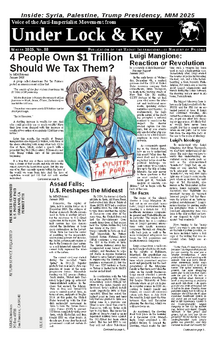
A Letter to a Young Gangster
I hope this letter finds you strong and defiant in mind, body, and spirit. I really enjoyed the few times we exchanged ideas about the new Black liberation struggle. I was a little surprised when you told me that you consider yourself a Black revolutionary because most young brothers who gang bang don’t identify themselves as such, and that’s because being one requires opposing and resisting racism and oppression which is a huge burden and responsibility. Others simply don’t understand the concept of a Revolutionary.
To put it simply, a Revolutionary is someone who fights and struggles to change the conditions of oppressed people. A counter-revolutionary is someone who-consciously or unconsciously–fights and struggles against change so as to exacerbate and perpetuate the conditions of oppressed people. A Revolutionary is someone who strives to transform the criminal mentality into a Revolutionary mentality. A counter-revolutionary is someone who maintains, values, and takes delight in the criminal mentality. A Revolutionary seeks to become a part of the solution to what’s plaguing the Black and oppressed communities. A counter-revolutionary seeks to remain a part of the problem of what’s plaguing the Black and oppressed communities. A Revolutionary is someone who utilizes all of his/her strength and energy in trying to liberate Black and oppressed people. A counter-revolutionary is someone who utilizes all of his/her strength and energy in trying to oppress and exploit those already oppressed and exploited by this white supremacist, capitalistic system. A Revolutionary is someone who opposes the Gestapo police who are daily murdering and brutalizing Black and oppressed people. A counter-revolutionary is someone who murders and brutalizes Black and oppressed people who are already being murdered and brutalized by the Gestapo police.
So, young brother, upon examining yourself, and taking the above examples of a Revolutionary into consideration, which category do you truly fall into: a Revolutionary or a counter-revolutionary? Most gang bangers, unfortunately, fall into the category of a counter-revolutionary.
As with most–if not all–Black street gangs, which I prefer to call social clubs, they started out as Revolutionary because the social, political and economic conditions that Black people were subjected to in the ’60s, ’70s, ’80s, and even today, necessitated that they come together and organize to try and resist and change those conditions. But during the ’80s when the CIA began flooding poor Black communities with crack cocaine and guns to finance its illegal counter-revolutionary war against the democratically-elected Sandinista government in Nicaragua, and to further destabilize the poor Black communities making them more susceptible to subjugation and genocide, these social clubs and the oppressed communities they existed in became fractured and divided. Consequently, these social clubs became counter-revolutionary in that they lost sight of their original purpose and began to prey on the very people and neighborhoods they originally organized to defend, protect, and liberate.
One of the best examples of a social club becoming Revolutionary as the result of a radical transformation in the mentality of its membership is the 5,000-strong Slauson gang under the leadership of Alprentice “Bunchy” Carter. During the early ’60s, Bunchy was successful in uniting all of the various social clubs in Los Angeles under his leadership. According to Elder Freeman, a close comrade of Buchy’s, this was the first and only time in history that there was only one unified social club in Los Angeles. To build off of that success and momentum, Bunchy then spearheaded the formation of the Los Angeles Black Panther Party in 1967 which recruited heavily from the ranks of the Slauson gang. Because Bunchy was such a dynamic organizer and a charismatic leader who inspired other “street” brothers and sisters to become Revolutionaries, then FBI Director, J. Edgar Hoover, had Bunchy and his Black Panther comrade, John Huggins, killed in a COINTELPRO created beef between the Los Angeles Black Panther Party and Ron Karenga’s United Slaves Organization on January 17, 1968. …
MIM(Prisons) adds: The above is an excerpt from an article written by a comrade who goes on to promote an organization that we reviewed in ULK 50.(1) In that article we describe the numerous serious political errors in that organization’s line. But we agree with the general strategy that we need to “unify rival social clubs and redirect their aggression and rage away from each other and towards changing and improving the conditions of Black and oppressed people.” There are many examples of comrades doing this that have appeared in the pages of Under Lock & Key over the years. Yet as this issue addresses, the problem is far from resolved.
The Black Panthers of the late 1960s still offer the most successful examples of transforming gangsters into revolutionaries. What that indicates is that building a strong vanguard party, with the correct political line, in dialectical relationship to the lumpen masses is the way to repeat their success. Without that, efforts at L.O. unity will be short-lived or will be siphoned off into bourgeois reformism.
Related Articles:








